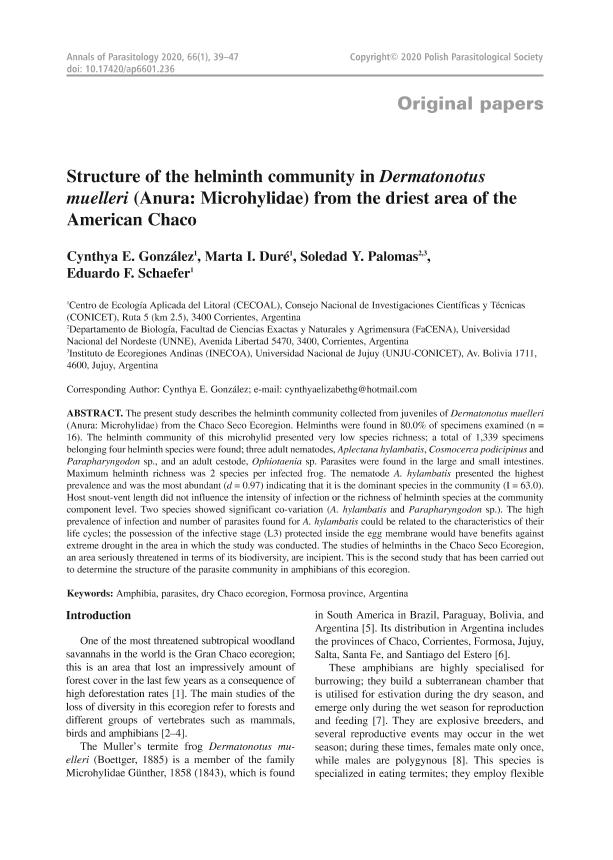Artículo
Structure of the helminth community in Dermatonotus muelleri (Anura: Microhylidae) from the driest area of the American Chaco
Gonzalez, Cynthya Elizabeth ; Duré Pitteri, Marta Inés
; Duré Pitteri, Marta Inés ; Palomas Alaniz, Yanina Soledad
; Palomas Alaniz, Yanina Soledad ; Schaefer, Eduardo Federico
; Schaefer, Eduardo Federico
 ; Duré Pitteri, Marta Inés
; Duré Pitteri, Marta Inés ; Palomas Alaniz, Yanina Soledad
; Palomas Alaniz, Yanina Soledad ; Schaefer, Eduardo Federico
; Schaefer, Eduardo Federico
Fecha de publicación:
03/2020
Editorial:
Polish Parasitological Society
Revista:
Annals of Parasitology
ISSN:
2299-0631
Idioma:
Inglés
Tipo de recurso:
Artículo publicado
Clasificación temática:
Resumen
The present study describes the helminth community collected from juveniles of Dermatonotus muelleri (Anura: Microhylidae) from the Chaco Seco Ecoregion. Helminths were found in 80.0% of specimens examined (n = 16). The helminth community of this microhylid presented very low species richness; a total of 1,339 specimens belonging four helminth species were found; three adult nematodes, Aplectana hylambatis, Cosmocerca podicipinus and Parapharyngodon sp., and an adult cestode, Ophiotaenia sp. Parasites were found in the large and small intestines. Maximum helminth richness was 2 species per infected frog. The nematode A. hylambatis presented the highest prevalence and was the most abundant (d = 0.97) indicating that it is the dominant species in the community (I = 63.0). Host snout-vent length did not influence the intensity of infection or the richness of helminth species at the community component level. Two species showed significant co-variation (A. hylambatis and Parapharyngodon sp.). The high prevalence of infection and number of parasites found for A. hylambatis could be related to the characteristics of their life cycles; the possession of the infective stage (L3) protected inside the egg membrane would have benefits against extreme drought in the area in which the study was conducted. The studies of helminths in the Chaco Seco Ecoregion, an area seriously threatened in terms of its biodiversity, are incipient. This is the second study that has been carried out to determine the structure of the parasite community in amphibians of this ecoregion.
Palabras clave:
AMPHIBIA
,
PARASITES
,
DRY CHACO ECOREGION
,
ARGENTINA
Archivos asociados
Licencia
Identificadores
Colecciones
Articulos(CECOAL)
Articulos de CENTRO DE ECOLOGIA APLICADA DEL LITORAL (I)
Articulos de CENTRO DE ECOLOGIA APLICADA DEL LITORAL (I)
Citación
Gonzalez, Cynthya Elizabeth; Duré Pitteri, Marta Inés; Palomas Alaniz, Yanina Soledad; Schaefer, Eduardo Federico; Structure of the helminth community in Dermatonotus muelleri (Anura: Microhylidae) from the driest area of the American Chaco; Polish Parasitological Society; Annals of Parasitology; 66; 1; 3-2020; 39-47
Compartir
Altmétricas



